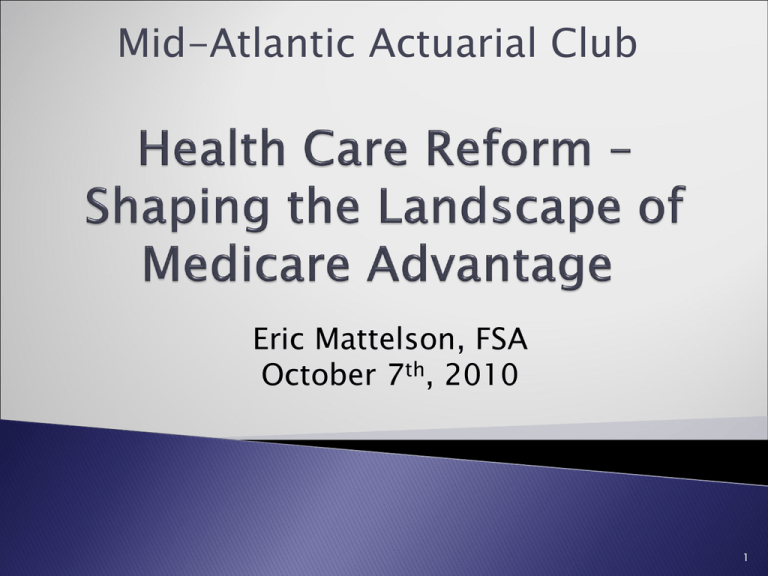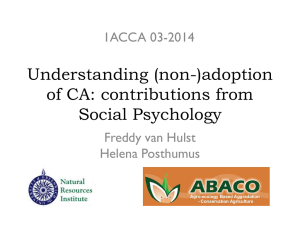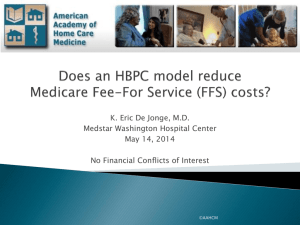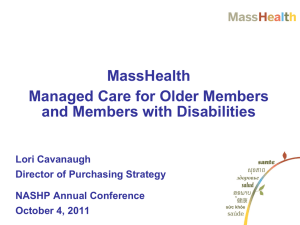Health Care Reform – Shaping the Landscape of Medicare Advantage
advertisement

Mid-Atlantic Actuarial Club Eric Mattelson, FSA October 7th, 2010 1 Background on Medicare Advantage (MA) Brief History Differences From Traditional Medicare Overview of the annual MA bidding process Healthcare Reconciliation Bill Outline key provisions that relate to MA – purpose/motivation of each one Implications to MA beneficiaries & plan sponsors Outlook for MA going forward – what must plans do to survive? 2 Education History Amherst College – 2006 FSA – 2008 Work History Aon Consulting (Baltimore) 2006-2008 Bravo Health (Baltimore) 2008-Current Disclaimer These are my personal opinions/interpretations Please do not ask me to tape any NFL games – I do not have express written consent… 3 Began in 1997 as Part of Balanced Budget Act Known at the time as Medicare + Choice Medicare Modernization Act of 2003 Improved plan reimbursement – led to more attractive benefit plans Added prescription drug coverage as an option starting 1/1/2006 Plans now known as Medicare Advantage (MA) Plans offering drug coverage known as Medicare Advantage & Part D (MA-PD) plans H.R. 4872 – Health Care & Education Affordability Reconciliation Act – 3/30/2010 4 Alternative to Traditional/Fee-for-Service (FFS) Medicare Run through private insurance companies Paid capitated rates by the government to provide healthcare services to Medicare beneficiaries Plan sponsor is responsible for paying claims and administering benefits Centers for Medicare & Medicaid Services (CMS) maintains oversight of MA plans 5 Plan Sponsor reimbursement Monthly Membership Reports (MMR) – eligibility Model Output Reports (MOR) – risk adjustment factors Plan Payment Reports (PPR) – payment summary files Annual Bid Process Review of each plan’s bids to ensure compliance Issues guidance & regulations Determines benchmark rates, coding factors, any other changes to payment rates Not a true “bid” (unlike Part D) – more like a projection High level administration of MA program 6 MA plans must cover everything that FFS does MA plans have option to cover additional benefits Part D drugs Routine Transportation Dental Routine Vision Exams & Eyewear Routine Hearing Exams & Hearing Aids Over the Counter drug benefit Fitness/Gym Membership Etc. Benefits can change from year to year 7 FFS – Coinsurance (usually 20%) – member pays % MA – Combination of coinsurance and fixed copayments Generally must be at least actuarially equivalent to FFS – often MA offers lower cost sharing than FFS Some benefit categories (Inpatient Hospital, Skilled Nursing, Mental Health, Dialysis, etc.) have more specific cost sharing thresholds Copays are generally preferable to beneficiary as costs are more predictable 8 Maximum out of pocket limit (MOOP) – caps the amount a member can potentially pay in a year FFS – no MOOP – can be very expensive when combined with coinsurance MA – Mandatory MOOP established starting in 2011 - $6,700 Prior to 2011, MOOPs were voluntary Plans can set the limit to less than $6,700 Cost sharing subsidy eligible dual members (Medicare/Medicaid) are exempt from this mandatory MOOP requirement since they do not actually pay their cost sharing 9 Premiums FFS – members pay standard Part B premium ($110.50 per month in 2010) If members want D coverage they must get a standalone drug plan for an additional premium MA – standard Part B premium + additional premium that varies by plan (some plans are $0) This can include Part D, in some plans at no extra cost MA premiums for a given plan can vary year to year Networks FFS – members can go to any provider who accepts Medicare MA – member may have provider network restrictions and authorization/referral requirements 10 HMO – members have network of providers, cannot voluntarily go out of network POS – Members have network of providers, can go out of network (OON) for selected services – OON cost sharing may be higher PPO – Members have network of providers, can go OON for any service offered innetwork, OON cost sharing may be higher 11 Special Needs Plans (SNPs) are designed to target a specific portion of the population Dual SNPs are for low income members who are both Medicare & Medicaid Eligible Chronic SNPs are for members with specific disease conditions (i.e. Diabetes) Institutional SNPs are for members who live in institutions These plans offer benefits/cost sharing/drug formularies specifically tailored to the target populations – FFS is one-size-fits-all 12 MA Plans are required to submit annual bids for each benefit plan to CMS Projection of membership by county (Revenue) Projection of medical cost Projection of administrative expense & margin Description of all benefits, cost sharing, plan premium Bids must be submitted by June of the preceding year 13 Benchmark (PMPM) Set by CMS for each county – updated annually Per Member Per Month (PMPM) amount Maximum amount that CMS will pay a plan sponsor for a member in that county Bid Rate (PMPM) Projected cost calculated by the plan sponsor for Medicare-covered services Plan Risk Score Average risk factor for projected members in the plan Both the benchmark & bid rate are multiplied by the plan’s projected risk score 14 Savings (PMPM) Difference between Benchmark and Bid Rate Rebates (PMPM) Savings * Rebate % = Rebate PMPM –> difference goes back to government Current Rebate % through 2011 is 75% Rebate dollars can be used for many things Reduce cost sharing for Medicare covered services Offer supplemental benefits (dental, vision, etc.) Buy down the cost of Part D benefits (for MA-PD plans) Cannot be kept by the plan sponsor as profit Plan Revenue = Risk adjusted bid rate + rebates 15 Use the following numbers as an example: Risk Score = 1.0 Benchmark = $1,000 Bid = $800 Savings = $200 Rebates = $150 Part D premium buy down = $50 Buy down of Medicare-Covered benefits = $75 Supplemental benefits = $25 MA-PD Plan Premium = $0 Projected Revenue = $800 + $150 = $950 16 CMS Maintains projections of FFS costs by county Current MA benchmarks are not explicitly adjusted for Medicare FFS costs Relationship between benchmarks and FFS costs varies considerably by county 11% of MA enrollees have benchmarks at or below FFS costs 78% of MA enrollees between 100% & 125% of FFS 11% of MA enrollees above 125% of FFS Current Membership weighted FFS ratio for 2010 is 110.4% Based on CMS MA membership data as of August 2010 http://www.cms.gov/MCRAdvPartDEnrolData/MMAESCC/list.asp#TopOfPage 17 Health Care Reform (HCR) bill will explicitly set county benchmarks as a % of FFS costs Counties will be ranked by FFS costs and divided up into quartiles Each quartile would have a target % of FFS costs that the benchmark would be set at New benchmarks begin phasing in as of 2012 Duration of new benchmark phase-in varies based on the total benchmark PMPM dollar reduction <$60 –> 2 years $60< X < $100 –> 4 years >$100 –> 6 years Motivation – cost savings 18 FFS Cost Quartile Target Benchmark % of FFS Current Benchmark % of FFS % of Aug 2010 MA Enrollees 1 95% 105% 45% 2 100% 109% 23% 3 107.5% 115% 15% 4 115% 135% 17% Total 101.4% 110.4% 100% 19 Quartiles are not membership weighted – skewed towards the top quartile Larger counties (urban) naturally have higher FFS costs Creates inherent winners & losers as some counties may actually see benchmarks remain flat while others will be dramatically reduced Could create member disruption as relative viability of markets could shift dramatically There is a provision that prevents new benchmarks from exceeding previous benchmark rates Holds MA plans “accountable” for how well FFS providers naturally manage costs (no control over this!) On average, counties will see a 8% reduction in benchmarks phased in over an average of 3.7 years 20 Assuming that we have a plan with an “average” mix of counties New Benchmark = $1,000 * (101.4%/110.4%) = $918.48 Bid = $800 Savings = $118.48 Rebates = $88.86 Part D premium buy down = $30 (50) Buy down of Medicare-Covered benefits = $44 (75) Supplemental benefits = $15 (25) 21 CMS currently gives every MA plan a star quality rating Prospective members can see plan overall ratings Range from 1 to 5 stars overall rating Overall rating is based on average scores across all individual measures No impact to payment methodology as of 2011 HCR bill will make certain payment factors dependent on plans’ star ratings starting in 2012 22 What factors influence star ratings? Part C has 36 ratings grouped into 5 domains Staying healthy – seeing PCP, getting HEDIS tests Health Plan Responsiveness & Care – ease of getting care, overall rating of health care quality Managing long term chronic conditions Member complaints & disenrollment rates Health plan’s customer service – time on hold, accuracy of information, non-English language support Similar factors go into the Part D plan ratings Some measures based on absolute thresholds, some based on plan’s relative scores 23 Plans that have 4 star or above overall rating get a quality bonus 5% increase in target FFS percentage (95% counties become 100% counties) Unclear if overall score will be based on scores for C&D or C only Phases in from 2012-2014 (1.5%, 3%, 5%) Plans can also qualify if they make “meaningful improvements” to their overall quality Plans can gain or lose these bonuses year over year – could create significant benefit changes/member disruption Motivation – to align a plan’s revenue with the quality of the healthcare delivered 24 Through 2011 all plans get to keep 75% of savings as rebate dollars Starting in 2012, rebate % will be dependent on star ratings 4.5 or more stars – 70% 3.5 to 4 stars – 65% 3 or fewer stars – 50% Phased in from 2012-2014 All plans will experience reduction in rebates which could vary by year creating disruption Motivation – cost savings 25 Original Bid After Provision 1 After Provision 1& 2 – <3.5 Stars After Provision 1& 2 – 3.5 Stars After Provision 1& 2 – 4 Stars After Provision 1& 2 – > 4 Stars Benchmark $1,000 $918.48 $918.48 $918.48 $964.40 $964.40 Bid $800 $800 $800 $800 $800 $800 Savings $200 $118.48 $118.48 $118.48 $164.40 $164.40 Rebate $150 $88.86 $59.24 $77.01 $106.86 $115.08 41% 61% 48% 29% 23% $888.86 $859.24 $877.01 $906.86 $915.08 6% 10% 8% 5% 4% Rebate Reduction % Plan Revenue Plan Revenue Reduction % $950 26 Loss of rebate dollars will result in either reduced benefits or increased MA premiums These provisions make getting the 4 star rating paramount – almost impossible to maintain benefits without that bonus These numbers assume that MA plan cost trend = FFS cost trend Benchmark trends with FFS cost Bid rate trends with MA plan cost 27 Coding factor explicitly reduces MA risk scores – direct reduction in MA payments Factor for 2010/2011 was 3.41% HCR mandates factor of at least 4.71% by 2014 HCR mandates factor of at least 5.71% by 2019 This means that risk scores will decline by at least 2.3% by 2019 Benchmark & Bid are risk adjusted, but this will decrease plan sponsor margin and reduce rebates slightly Motivation – cost savings 28 Establishes a minimum loss ratio (LR) for MA plans at 85% starting in 2014 Plans that have LR below 85% must pay back to CMS the difference between current LR and 85% If LR is below 85% for 3 consecutive years – MA plan cannot enroll new members If LR is below 85% for 5 consecutive years – plan contract will be terminated This LR will be enforced at the entity level, not the plan sponsor level This also applies to Part D plans Motivation – cost savings? 29 Creates a very narrow financial window for plan sponsors Loss ratios are not that stable/predictable Bids must be filed over a year in advance – bid LR may not equal actual LR Potentially severe sanctions – no allowance/buffer – 84.5% LR treated same as 75% LR Cannot have cross regional/entity subsidization unless under same legal organization Calculated including 5% quality bonus – gaining or losing that bonus could determine whether LR is in acceptable range 30 Creates possible adverse incentives Assume admin ratio is 10% - at 85% LR profit is 5% Plan Sponsors will still follow profit maximization strategy What if a plan does a really good job at managing cost and actual loss ratio is 80% A plan can reduce quality improvement programs (which uses admin dollars) – maybe lose the quality bonus New admin ratio is 8% and LR is now 85% - profit is 7% The plan is better off financially by doing a less comprehensive job of managing the health of their members 31 Current legislation incentivizes plan sponsors to manage costs as efficiently as possible Lower costs = more bid rebate dollars, better benefits, & better competitive position Lower costs also = higher profit margins Loss ratio floor distorts these incentives Profit maximization <> cost minimization Plans may try to bid more strategically – may cut benefits further to maintain what little margin is still attainable 32 Current 2010 Part D benefit design: Beneficiary Beneficiary Beneficiary Beneficiary pays pays pays pays 100% up to $310 deductible 25% up to ICL ($2,830) 100% through donut hole ($6,440) 5% above catastrophic threshold Proposal to reduce the cost sharing on generic drugs in the donut hold Phase in at 7% coinsurance reduction per year starting in 2011 down to 25% in 2020 Motivation – to reduce beneficiary cost sharing liability & incentivize generic utilization 33 Positive for member Reduces beneficiary liability Increases incentives for increased generic utilization Increases the cost of offering Part D Sponsors may choose to remove Part D rather than increase premiums or reduce MA benefits Stand alone PDPs may increase premiums or restrict drug formularies – hurts beneficiaries on Original Medicare as well Unclear whether this will affect provider behavior – may still prescribe brand drugs 34 Quick Recap of provisions Set MA benchmarks based on FFS target % Rebate % and quality bonus based on star rating Increased MA coding factor – reduce risk scores Minimum loss ratio floor at 85% Phase down of coinsurance % for generic drugs in donut hole 35 Changes to benefit offerings Many of the ancillary benefits that attract members to MA will be reduced or removed Cost sharing will trend upwards towards FFS equivalent levels Member premiums will increase Some plans/regions will be hit harder than others Urban areas generally have lower FFS targets – will see the greatest reduction in benchmarks Urban areas may have more sophisticated providers – may manage their FFS costs better already Plans with sicker populations may not be able to maintain products designed for those members (SNPs) 36 Changes to competitive balance Only plans who can manage costs well can survive Will force many plan sponsors out of business Good for overall efficiency/cost savings of MA Bad for the members – reduces options Even successful plans may have to pare down plan offerings – Chronic SNPs may disappear Some regions may become unviable for MA – will cause member disruption MA-PD plans may not be able to afford the PD component unless it is funded through member premiums 37 It will be difficult going forward but there are things a MA plan can do to improve its prognosis: Attain & Maintain 4 star quality rating 5% benchmark bonus could be the difference Relies on good relationships with providers for HEDIS scores, delivery of care ratings, & managing chronic conditions rating Solid customer service & member retention Offer the most consistent benefits that the plan can afford to minimize year over year fluctuations 38 Strong provider relationships Helps maintain high star ratings Manage the health of the members – improves member satisfaction & reduces healthcare costs Ensure members are accurately coded so that risk scores reflect the member’s health status – chronic conditions must be coded every year to maintain risk scores Benefit design – providers are a window into the member’s needs – can use this information to help make decisions during bid process 39 Membership growth & retention Larger membership base = economies of scale -> lower admin cost % More stable population – easier to bid & predict costs & loss ratios to meet the LR floor requirements Stable year over year performance means fewer benefit changes are required If margins are reduced, the plan sponsor must make it up through volume to pay for fixed admin costs 40 As plan sponsors exit the marketplace, the biggest competition will be FFS Medicare Key benefits (ancillary benefits, MOOP, Part D) must be maintained to differentiate MA from FFS Branding/marketing will be essential Highlight the benefits of HMO – ease of claim payments, strong relationship with PCP, etc. Member communications & customer service key to maintaining member satisfaction 41 MA was designed with a purpose Improve efficiency of healthcare delivery through managed care Offer a valuable alternative to Medicare FFS To provide options that address the needs of a disparate Medicare population Provide members with additional benefits including drug coverage in one integrated package Improve the beneficiary’s health status through strong relationships with PCPs Allow the Medicare program to reap the benefits of capitalism without compromising the quality of care (natural competition promotes efficiency) 42 HCR has presented the most significant changes to MA since 2003 It is possible to survive and still achieve the goals that MA was designed for but it won’t be easy… Actuaries will be essential Bid Development Financial Projections Modeling the impact of future changes 43 Thank you for your time 44






